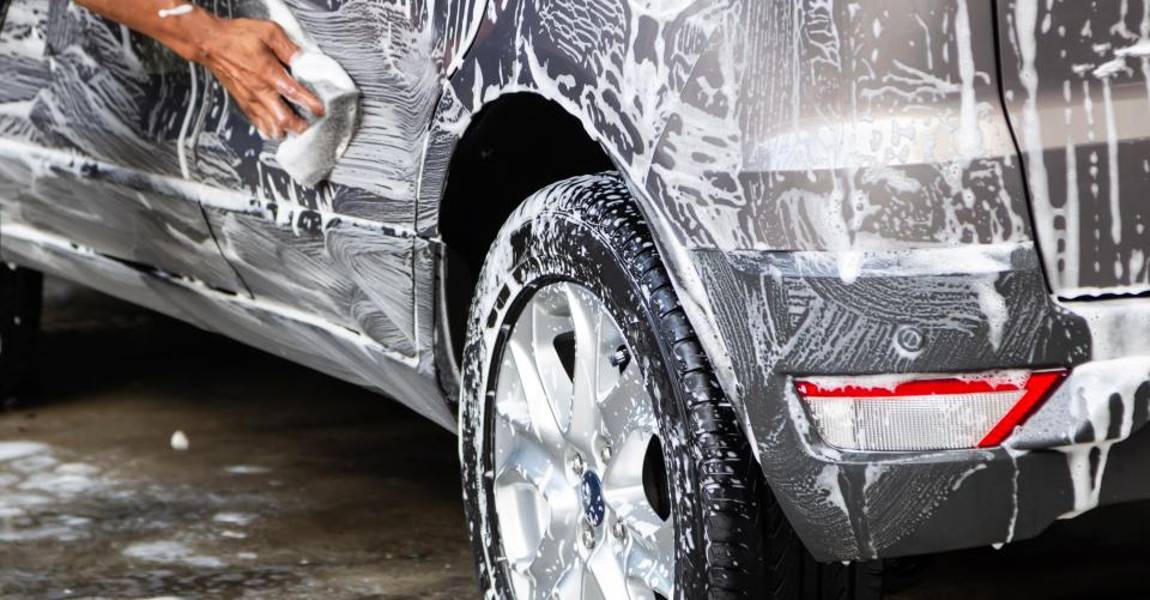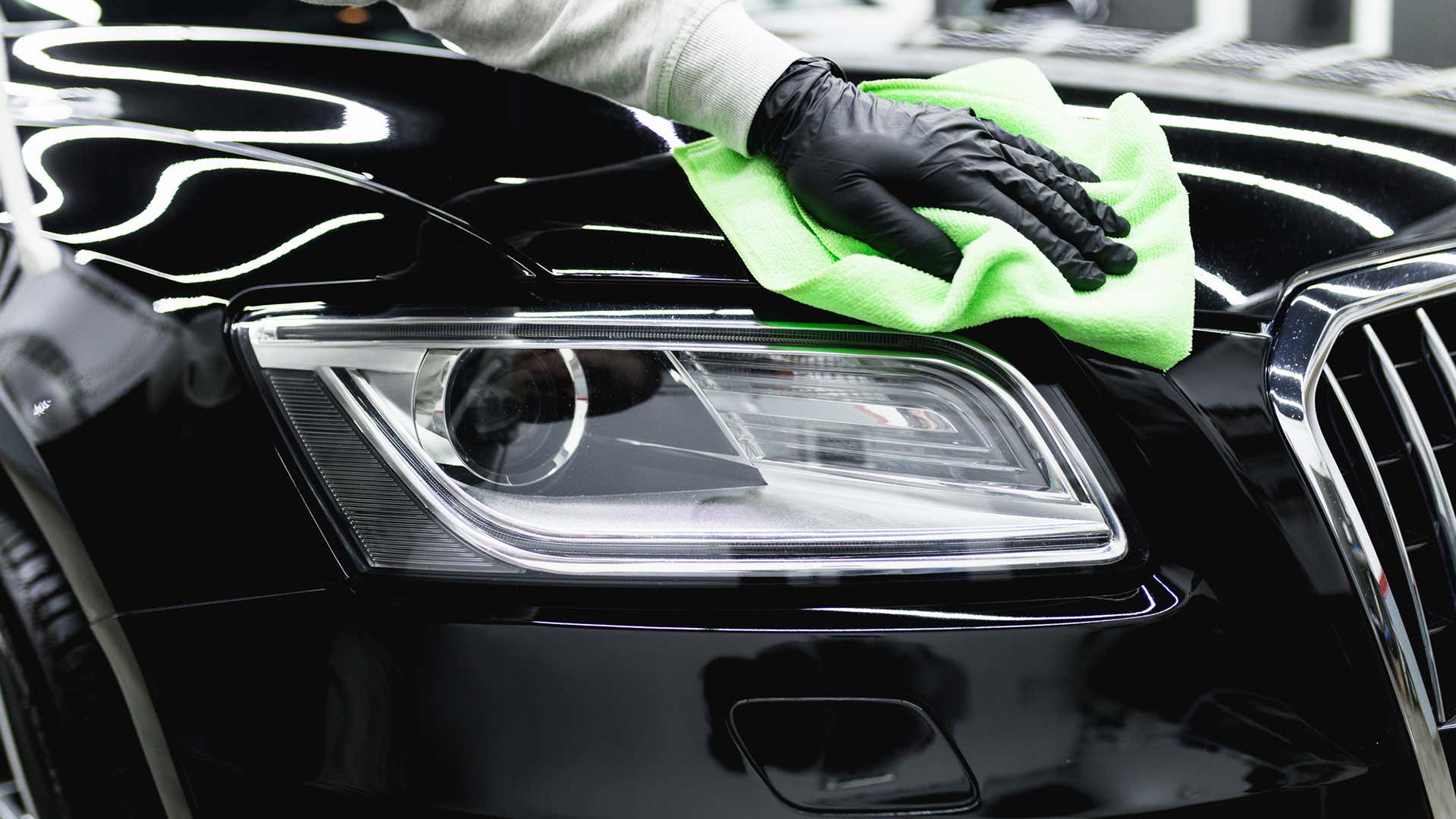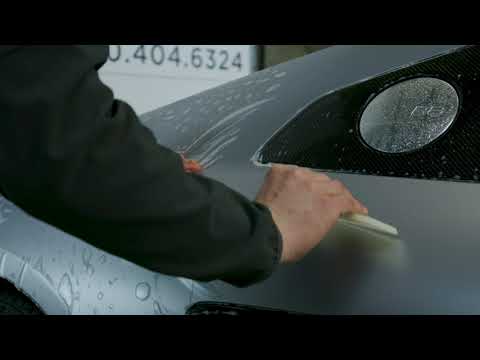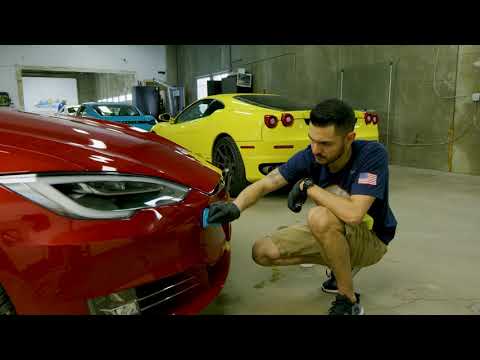Ceramic coating has become increasingly popular as a way to protect and enhance the appearance of cars. But what exactly is ceramic coating, and how does it work to protect your car’s paint? This blog post will explore the science behind ceramic coating and its many benefits.
Table of Contents
- What’s Ceramic Coating for Cars?
- The Composition of Ceramic Coatings
- Ceramic Coating Technologies
- How Ceramic Coating Works
- Benefits of Ceramic Coating for Your Car
- How To Maintain a Ceramic-Coated Car
- FAQ’s
- Conclusion

What’s Ceramic Coating for Cars?
Ceramic coating is a liquid polymer applied to a car’s exterior to provide exceptional protection for the paint and surface.
This cutting-edge technology creates a transparent layer that chemically bonds with the car’s factory paint, ensuring long-lasting durability and resistance to environmental damage.
It can benefit car owners by providing an added layer of automotive protection, shielding the paint from scratches, oxidation, and contaminants such as bird droppings and tree sap.
The hydrophobic properties also make it easier to clean and maintain the car’s appearance.
Importance of Protecting Your Car’s Paint
Protecting your car’s paint and surface is crucial in maintaining its value and aesthetic appeal. The exterior of a vehicle is susceptible to damage over time due to constant exposure to UV rays, dirt, and other elements.
By applying Opti-coat Pro, a car owner can ensure that their investment is protected and retains its shine for years to come.
Its advanced technology and bonding properties provide exceptional protection for a car’s exterior. It is a wise investment for car owners looking to preserve the quality and appearance of their vehicles.

The Composition of Ceramic Coatings
High-quality nano-ceramic coatings, are known for their hydrophobic nature, which repels water and other liquids. This hydrophobic property results from the protective properties at a molecular level.
The primary component is silicon dioxide, which creates a superhydrophobic surface that prevents water and other liquids from adhering to the surface. This makes the surface easier to clean but also provides long-term protection against environmental elements, making it an ideal choice for a variety of materials.
The hydrophobic nature offers several benefits, including easy cleaning and maintenance.
Due to their water-repelling properties, surfaces coated with high-quality ceramic coatings are less prone to water damage, staining and corrosion. This makes them suitable for a wide range of applications, from automotive and marine to industrial and residential.
The molecular-level protection provided by nano-ceramic coatings ensures that the surfaces remain in top condition for longer periods, reducing the need for frequent maintenance and replacement.
With the ability to repel water and other liquids, these are a valuable solution for protecting and preserving various materials in different environments.
Titanium Dioxide: The Key Ingredient for UV Protection
Titanium dioxide is the key ingredient for UV protection. Its ability to absorb and dissipate harmful UV rays helps to protect underlying surfaces from sun damage. This is crucial for preserving the appearance and structural integrity of surfaces exposed to sunlight.
Titanium dioxide enhances the durability and resistance against color fading and surface corrosion. This ensures that the coated surfaces maintain their original appearance and strength over time, even in harsh environmental conditions.
Various forms utilize titanium dioxide for UV protection, with different measurements and thicknesses.
For instance, some may contain titanium dioxide in 5-10% concentrations, while others may have higher percentages depending on the specific application.
The thickness of it also determines the level of UV protection provided.
Titanium dioxide play a crucial role in enhancing the performance by providing superior UV protection and improving their durability and resistance against environmental factors.
Silicon Dioxide: Enhancing the Hydrophobic Properties
Silicon dioxide, commonly known as SiO2, is a key component in enhancing the hydrophobic properties of ceramic coatings. When applied to a surface, silicon dioxide creates a high contact angle with water droplets, causing them to bead up and roll off the surface instead of spreading out and sticking. This creates a water-repellent effect, making the surface easier to clean and reducing the chances of water spots.
The presence of SiO2 nanoparticles in ceramic coatings plays a crucial role in minimizing water spotting and preserving a spotless and polished look on car surfaces. The nanoparticles work to provide a protective layer that repels water and prevents it from bonding to the surface. This facilitates easier cleaning and ensures that the surface remains spotless for an extended period.
Silicon dioxide enhances the hydrophobic properties of ceramic coatings by creating a high contact angle with water, causing it to bead up and roll off the surface. The presence of SiO2 nanoparticles further minimizes water spotting, facilitates easier cleaning, and preserves a spotless and polished look on car surfaces, thereby increasing the overall water repellency.
Other Components in Creating a Protective Barrier
Zirconium oxide and alumina are crucial components in creating a protective barrier in ceramic coatings. Zirconium oxide, also known as zirconia, is highly resistant to corrosion, making it an excellent choice for enhancing the durability. Alumina, on the other hand, adds to the hardness and wear resistance of the protective coating.
When combined, zirconium oxide and alumina form a shield-like barrier on the surface, increasing the level of protection against environmental factors such as road salt and bug splatters. Zirconium oxide and alumina work together to create a protective layer that prevents the underlying surface from being damaged.
Their specific properties, such as high hardness and resistance to corrosion, are essential in increasing the overall durability of the ceramic coating. By incorporating zirconium oxide and alumina into the formulation, the coating offers a range of benefits, including enhanced resistance to wear and tear, extended longevity, and improved performance under harsh conditions.
Zirconium oxide and alumina are vital in forming a protective barrier in ceramic coatings. This ensures a high level of protection and increases the coating’s overall hardness and resistance.
Ceramic Coating Technologies
Ceramic coatings are a popular choice for protecting various materials, with liquid and powder coatings being the most common types. Liquid ceramic coatings are typically applied using a spray gun, while powder coatings are applied through a process called electrostatic spray deposition.
These can be applied to various materials, including metal, plastic, and glass, offering excellent protection against corrosion, UV damage, and chemical exposure. In the automotive industry, ceramic coatings are commonly used to protect the paintwork from scratches, swirl marks, and fading, providing a durable and long-lasting finish.
The chemical composition often includes silicon dioxide and titanium dioxide, which bond to the surface at the molecular level. This strong bond creates long-lasting protection that is resistant to heat, chemical abrasion, and water.
The application process involves bonding with the surface at a molecular level, ensuring a strong and durable finish.
They offer excellent protection for various materials, with liquid and powder coatings being the most common types. In automotive applications, ceramic coatings provide strong protection for paintwork, offering benefits such as scratch resistance, UV protection, and a high-gloss finish.
According to a study conducted by the American Ceramic Society, ceramic coatings can provide up to 9H hardness on the Mohs scale, making them highly resistant to scratches and swirl marks. This level of hardness ensures long-lasting protection for the car’s paintwork, keeping it looking new for a longer time.

How Ceramic Coating Works
In the automotive care and maintenance world, paint protection has become crucial for preserving a vehicle’s overall appearance and value.
Automotive paint protection refers to the various methods and products used to safeguard the exterior paint job from damage caused by environmental hazards, such as UV rays, bird droppings, dust, and road grime.
One of the most effective and long-lasting paint protection is ceramic coating. This liquid polymer chemically bonds the entire vehicle surface to create a layer of protection. This innovative solution is known for its durability, hydrophobic properties, and resistance to chemical etching.
It is ideal for those looking to maintain a pristine and glossy finish on their vehicles.
In the following sections, we will explore the benefits and process of how ceramic coating works to provide superior paint protection for automotive surfaces.
Benefits of Ceramic Coating for Your Car
Ceramic coating for your car offers many amazing benefits that makes it a worthwhile investment for vehicle care.
- It provides long-lasting protection against UV damage and paint fading, ensuring that your car’s exterior keeps a glossy sheen for years to come.
- The enhanced protection against scratches and the long-term durability of the car’s surface offer long-term protection, preserving the vehicle’s resale value and attracting potential buyers in the future.
- The coated surface makes the cleaning process much easier and reduces the need for regular maintenance, saving you time and effort. This makes your car’s exterior look pristine and keeps it in top condition
With these incredible benefits, ceramic coating is a smart investment for preserving your vehicle’s aesthetic appeal and longevity.
Whether you want to sell your car in the future or enjoy a beautifully maintained vehicle, the protection and ease of maintenance provided by a coating make it a valuable choice. Take advantage of the opportunity to give your car the ultimate protection and proper care it deserves.
Long-Lasting Protection Against Environmental Damages
Ceramic car coatings provide long-lasting protection against environmental contaminants such as UV rays, harsh chemicals, and abrasive materials. They create a durable barrier that shields the car’s paint from minor scratches and other forms of damage. With proper maintenance, ceramic car coatings can last for years and offer superior resistance to environmental factors.
The protective qualities of ceramic coatings come from their chemical bond with the car’s paint, ensuring that the protection does not easily wear off. Unlike traditional wax or sealants, advanced coatings offer a much stronger and longer-lasting shield against UV rays, oxidation, and chemical stains.
They also provide a higher level of protection compared to paint protection film.
They are an effective way to maintain the appearance of a car’s finish while providing long-lasting protection against environmental contaminants. Their ability to resist UV rays, harsh chemicals, and abrasions makes them an essential investment for anyone looking to keep their car looking new for years to come.
Research by the Society of Automotive Engineers (SAE) has shown that ceramic coatings can provide thermal barrier protection, reducing the heat absorption of the car’s exterior surfaces by up to 30%. This helps to prevent heat-related damages such as fading, cracking, and warping and also improves the energy efficiency of the vehicle by reducing the need for air conditioning during hot weather.

How To Maintain a Ceramic-Coated Car
To maintain a ceramic-coated car, it is important to follow these steps:
1. Regularly wash the car using a pH-neutral shampoo and a microfiber wash mitt to avoid scratching it.
2. Dry the car thoroughly after each wash to prevent water spots from forming.
3. Use a ceramic coating-specific spray or detailer to enhance and maintain the hydrophobic properties.
4. Avoid washing the car in direct sunlight or high temperatures, as this can cause the shampoo or detailer to dry too quickly and leave streaks.
5. Avoid using abrasive products or harsh chemicals that can damage the ceramic coating. Stick to gentle cleaning agents and microfiber towels.
6. Consider applying a ceramic coating booster or topper every few months to restore and prolong the longevity of the ceramic coating.
7. Regularly inspect the ceramic coating for any defects or areas that may need touch-ups. If necessary, consult a professional for reapplication or maintenance services.
FAQ’s
What is the Lifespan of Ceramic Coating?
The lifespan can vary depending on factors such as the quality, maintenance, and environmental conditions. On average, it can last for five years.
Can the Ceramic Coating be applied to any car surface?
No, it cannot be applied to any car surface. It is typically recommended for painted surfaces, such as the car’s exterior paintwork. It may not adhere properly or provide the same benefits if applied to surfaces like plastic trim, rubber seals, or glass. It is important to consult with a professional or read the product instructions to make sure it’s the proper application method.
Is a Professional Application Necessary, or Can I Do It Myself?
Having a professional application is unnecessary, as it is possible to do it yourself. However, proper knowledge, skill, and equipment are required to ensure a successful application. You can try it yourself if you are confident in your abilities and have the necessary tools. Otherwise, it may be best for you to seek the help of a professional for a more professional and long-lasting result.
Conclusion
In summary, ceramic coating is an essential protective layer for your car. It provides a strong and long-lasting barrier against various environmental factors such as UV rays, dirt, debris, and scratches. By understanding the science behind ceramic coating, car owners can make an informed decision to protect their prized possessions.
If you are located in Colorado and looking for professional ceramic coating services, look no further than Colorado Clear Bra. Their team of experts specializes in high-quality ceramic coating applications, ensuring your car receives the utmost protection and shine. Don’t wait, take action today and give your car the protection it deserves with Contact Colorado Clear Bra.




